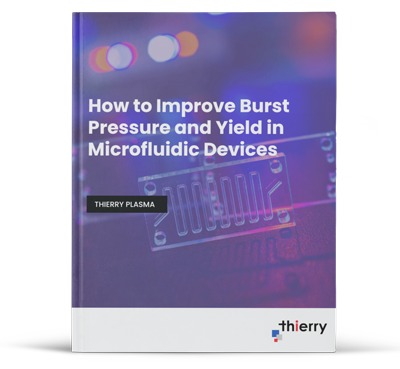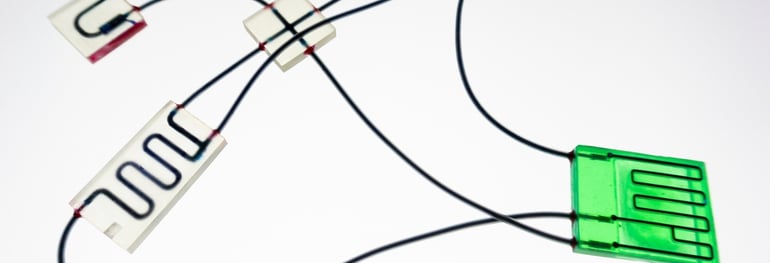
Polydimethylsiloxane (PDMS) is a popular material widely used in the manufacture of low-cost microfluidics devices designed for rapid prototyping in research. PDMS, however, requires a surface treatment step to produce strong, conformal bonds between surfaces.
To form the functional micro features that are central to optimal device performance, the channels which are open after fabrication have to be sealed without clogging, changing their physical parameters, or altering their dimensions. Sealing the open microchannels is necessary to produce the device’s final enclosed fluid paths. This is a critical step in the fabrication process and invariably involves bonding a caping layer to the microchannel substrate.
Bond strength is a crucial consideration and bond interfaces must provide suitable chemical or solvent compatibility to prevent degradation during use, without compromising dimensional control of the microchannels due to deformation during the bonding process. Compounding the issue is the need to achieve appropriate burst pressure to ensure the reliable activation of pressure-controlled microchannel valves, and that requires excellent bonding. Since less-than-ideal bonding surfaces are typically the root cause of poor adhesion, raising the surface energy of both materials is often the best way to improve bonding capabilities and, consequently, adhesion.


It can be difficult to bond PDMS to other materials, such as polyimides and glass, due to the fact that PDMS is both chemically inert and highly hydrophobic. Fortunately, plasma treatment has been shown to improve the wettability of both surfaces by raising the surface energy.
Plasma treatment of PDMS used in microfluidic devices produces a permanent covalent bond between surfaces (they share electrons to produce a very strong bond), forming a practically inseparable seal between layers and improving analyte flow within microfluidic channels. Plasma-activating the surface with a brief air or oxygen plasma treatment enables it to bond very easily to another PDMS or glass sample's surface. This can be done using a MHz generator in a plasma system with a total cycle time under five minutes. The two materials can then be bonded together using very little pressure on both sides to create a chemical adhesion between the molecules on both surfaces.
It is vital to have a clean and activated surface to create a proper bond -- plasma cleaning and activation is the only way to prepare surfaces for PDMS bonding. However, some plasma systems are not optimized to prepare PDMS for proper bonding. It often requires a PC-controlled system to accurately repeat the proper processes over and over again for the reliability necessary to manufacture devices in volume.

Microfluidic devices must be made in a clean environment. Any contamination from particulates can cause poor surface activation that will result in ineffective bonding and, ultimately, product failure. Unfortunately, PDMS can be easily contaminated at several different points in the manufacturing process. During its formulation, PDMS can be contaminated with residues associated with the process, resulting in poor surface quality. Cleaning this surface with plasma can improve surface quality but extra care should be used when formulating PDMS.
PDMS can also be contaminated during plasma treatment. This is why a plasma activation system must utilize a borosilicate or quartz glass chamber. Unlike metal chambers, glass will ensure clean instruments for plasma activation, resulting in properly bonded microfluidic devices. Using a vacuum pump without PFPE lubricating oil is also preferred so that fluorinated contamination isn’t introduced into the facility.
Oxygen also plays a key role in plasma surface modification of PDMS. After patterning a PDMS substrate by replica molding from a master mold, the PDMS is oxidized in air or oxygen (O2) plasma. An air or O2 plasma removes organic hydrocarbon material by chemical reaction. Oxygen is more efficient than air due to the higher concentration of reactive oxygen species; air from an environment prone to daily fluctuations in humidity or particulates can adversely affect PDMS bonding.
Regardless of which you use air or oxygen – when the process is successfully completed, it leaves silanol (SiOH) groups on the surface, rendering the surface more hydrophilic and increasing surface wettability. After plasma activation, the PDMS is immediately placed in contact with another oxidized PDMS or glass surface, creating an irreversible seal. This watertight covalent bond is ideal for microchannel formation and function.
There are a lot of elements involved in the production of microfluidic devices and it’s critical that the production team is well-educated in each step and any factors that can influence them. This will be instrumental in helping you move beyond successfully producing several functional devices to scaling up for volume production with a minimal rework and rejection rate. By analyzing device characteristics such as burst pressures, you can identify weak spots in device design and manufacturing, enabling you to seek proper solutions for creating a stable and repeatable manufacturing process.
Understanding all of the costs of manufacturing microfluidic devices, including scrap and product failures in the field, will provide even broader insights that can lead to smarter investments and improved manufacturing processes and controls.

When manufacturers go the route of using a plasma system without proper controls to gain a reduction in startup price the product quality suffers, leading to an increase in scrap which will, in turn, cost the company additional money. Eventually the wasted money will add up to more than the actual system upgrade would have cost.
The recommended solution is to utilize a system with repeatable process controls. This will enable uniform plasma activation for better bonding, increased burst pressure, improved product performance, and minimal rejection rates.
To ensure you choose the right plasma system to effectively treat PDMS for your microfluidic device, it’s important to understand what systems do NOT work well. For example, plasma systems that have a capacitive coupled electrode can cause problems if not configured correctly. This type of system features a wire wrapped around the vacuum chamber as the electrode – if the electrode is not optimized for uniformity the plasma will not be uniform and the electrode can produce hot spots in the plasma.
Plasma systems with a metal chamber are also not suitable for PDMS bonding. Using a metal chamber can generate microscopic particles that can produce pockets of non-contact between surfaces on your bonded device which, in turn, can lead to product failure.
Using a vacuum pump that contains Krytox, Fomblin, or other PFPE-containing fluids can be damaging to the PDMS device as well. These pumping fluids contain fluorosilicones which are very difficult to clean off a surface. They can also migrate readily throughout a lab or manufacturing facility through contact-to-contact transmission. Once the facility is contaminated with the fluorosilicone, it is extremely difficult to clean.
A plasma system that utilizes repeatable process controls enables accurate, uniform plasma activation that can be reliably duplicated over and over again. This will eliminate the “craftsman” approach that requires the human operator to manually tweak the process on a constant basis in order to achieve relatively consistent production results.
Optimal activation produces optimal bonding. This results in increased burst pressures for better device reliability and greater overall production yield. To accomplish this a number of factors come into play: accurate pressure control, gas settling timing, process timing, and good power control. These precise parameters can make the difference between a consistent-quality microfluidic device and a failed product.
Use the insights provided above as part of a set of criteria for determining the features you will need for successful plasma treatment in your specific device manufacturing process. Other considerations include:
Together, these criteria will help you evaluate the various systems available and select the one that best fits your needs.

Thierry Plasma systems are great options for critical PDMS applications. From small research or lab-scale projects with the Zepto and Atto plasma systems to larger, higher-throughput applications requiring bigger, fully customizable systems. All of these systems are offered with installation and on-site training to ensure your plasma treatment process is successfully implemented to achieve the desired goals. All systems can also be serviced by Thierry Plasma to ensure peak performance and a long, productive life.
Interested in exploring how plasma technology can benefit your specific application and your organization but are unsure of what you need and how your potential purchase will perform for your particular project? Thierry can often provide a test study free-of-charge to help you determine its efficacy and efficiency as well as the benefits of plasma technology.
We also offer manufacturing process consultations to provide insight into how a plasma system can fit into your production process and manufacturing line. If you need some assistance in getting the most out of your plasma system, we even offer periodic plasma-processing workshops that provide valuable plasma treatment tips and techniques.
To learn more about surface modification, check out our publication, Plasma Technology: Thierry’s Surface Modification Solutions for Manufacturers.
For more information about our complete line of plasma products and services and the get a system quote, contact us today.

Plasma: +1 (248) 761 9253
Distribution: +1 (248) 549 8600
Fax: +1 (248) 549 3533
info@thierry-corp.com